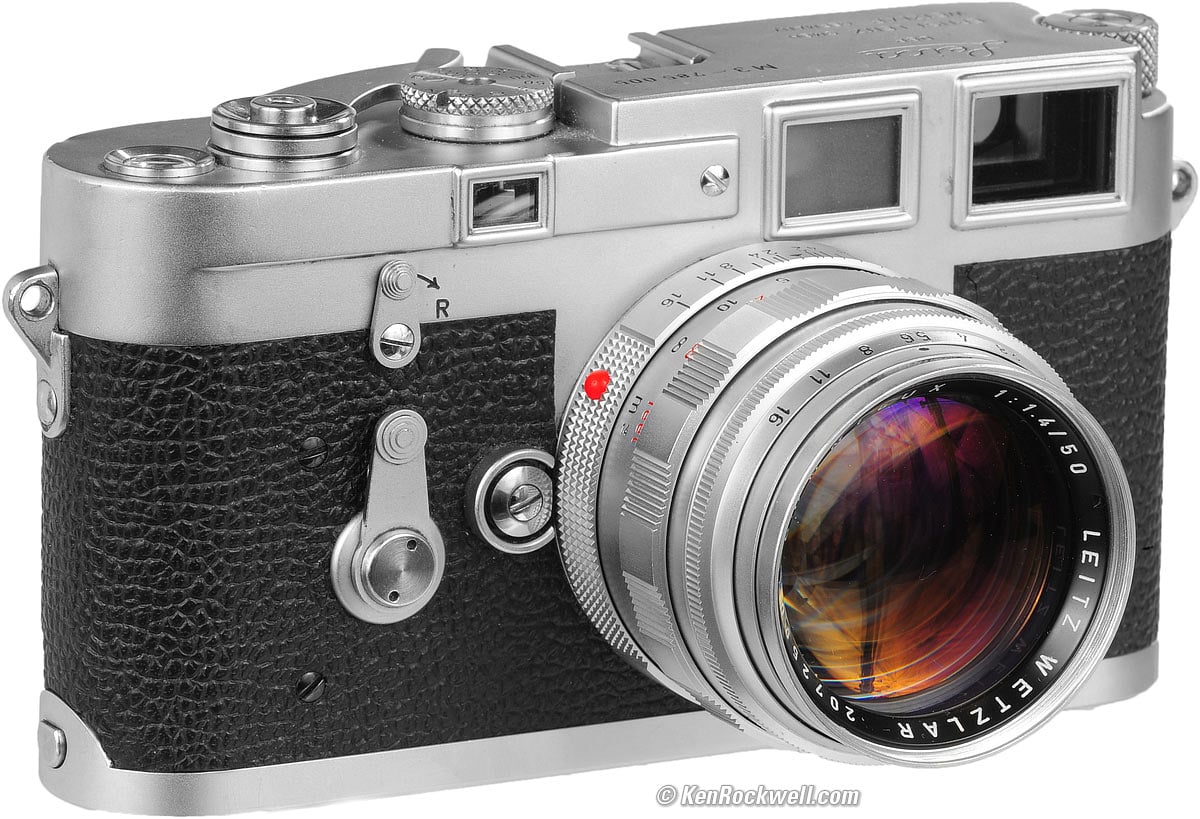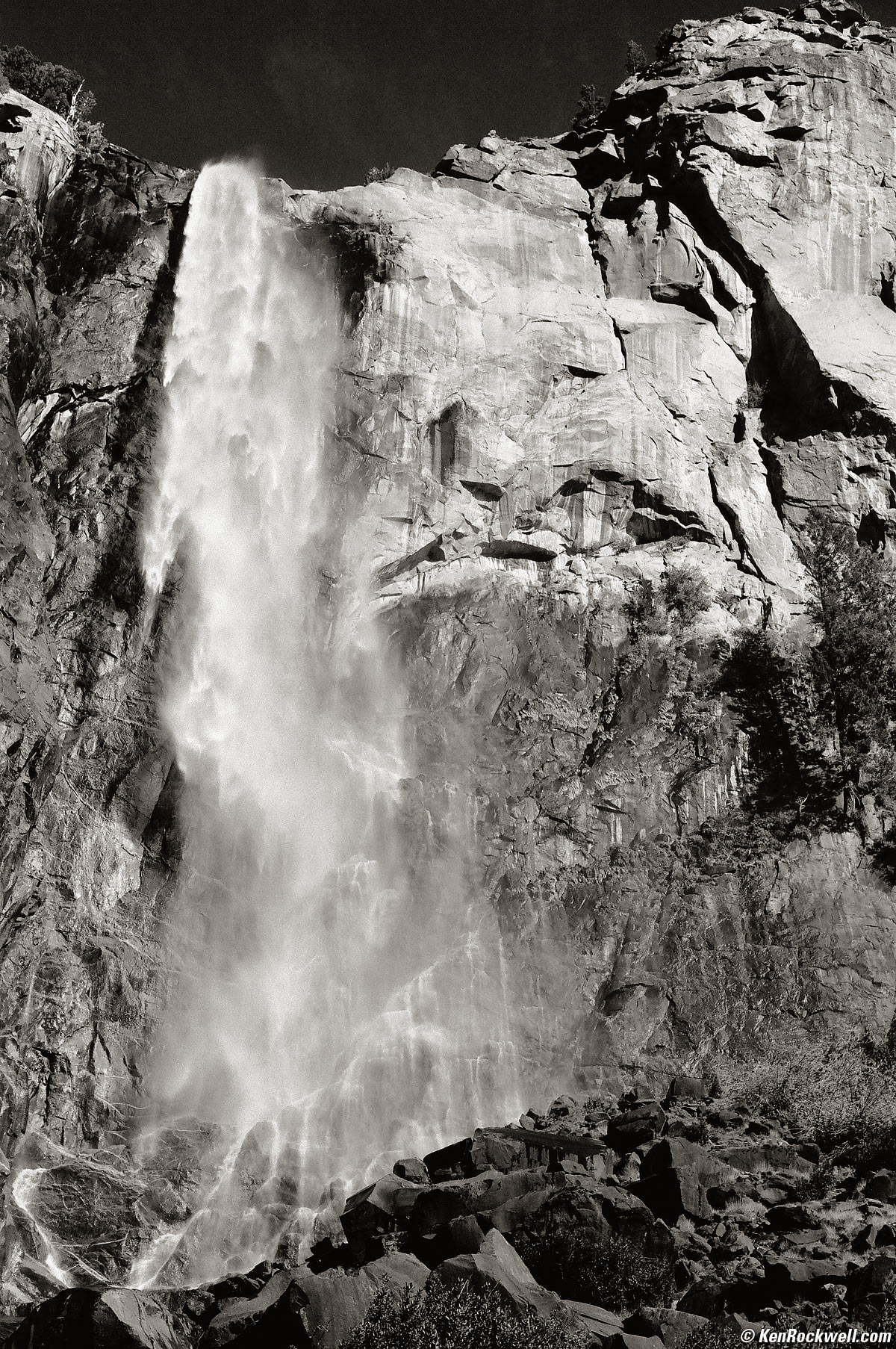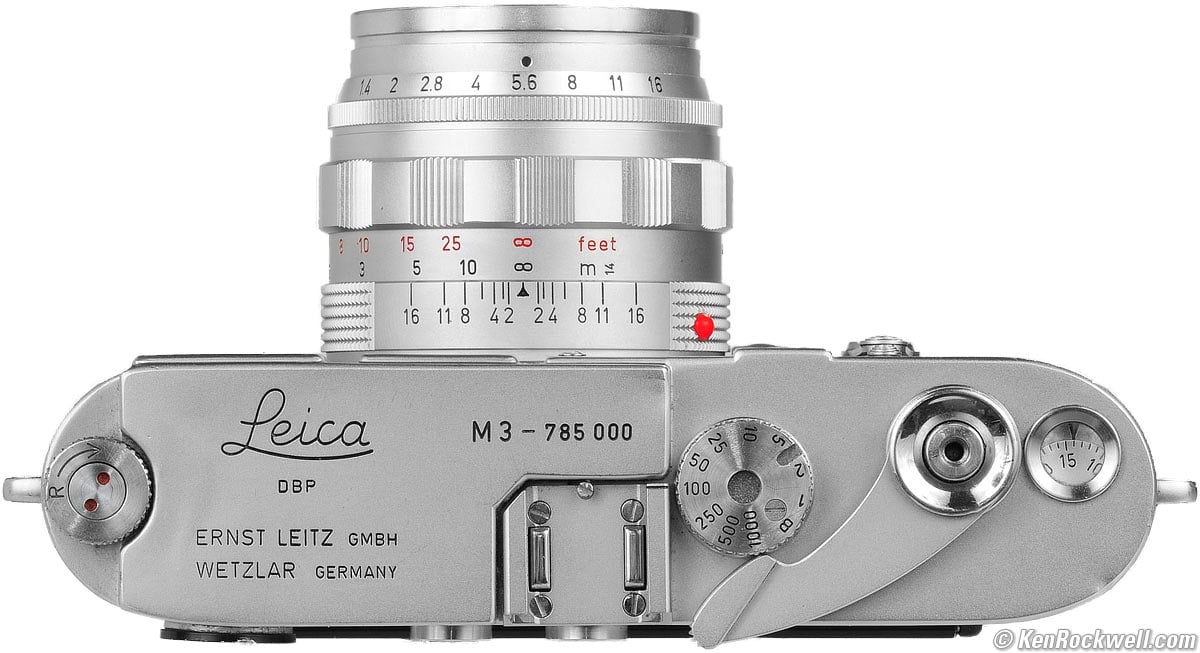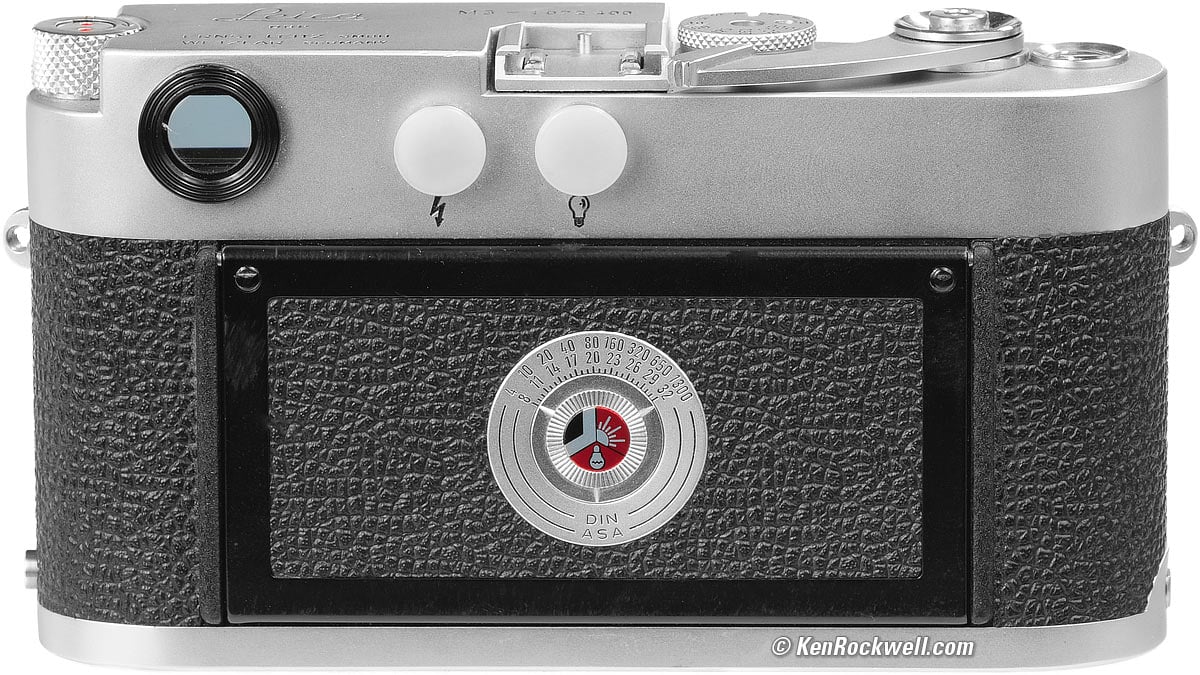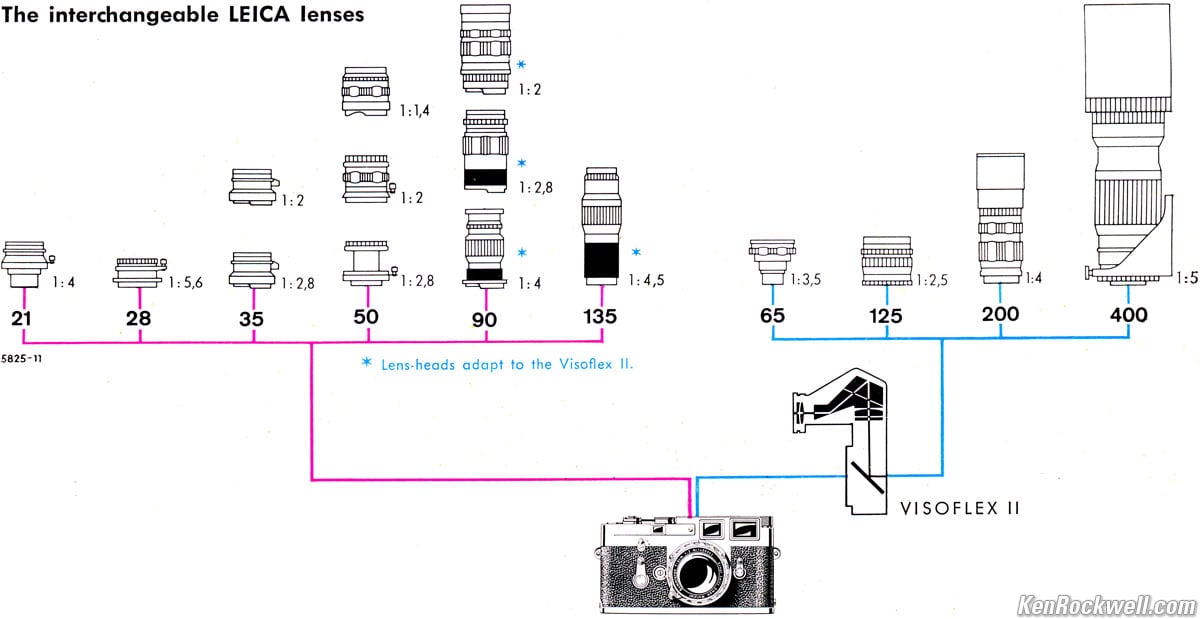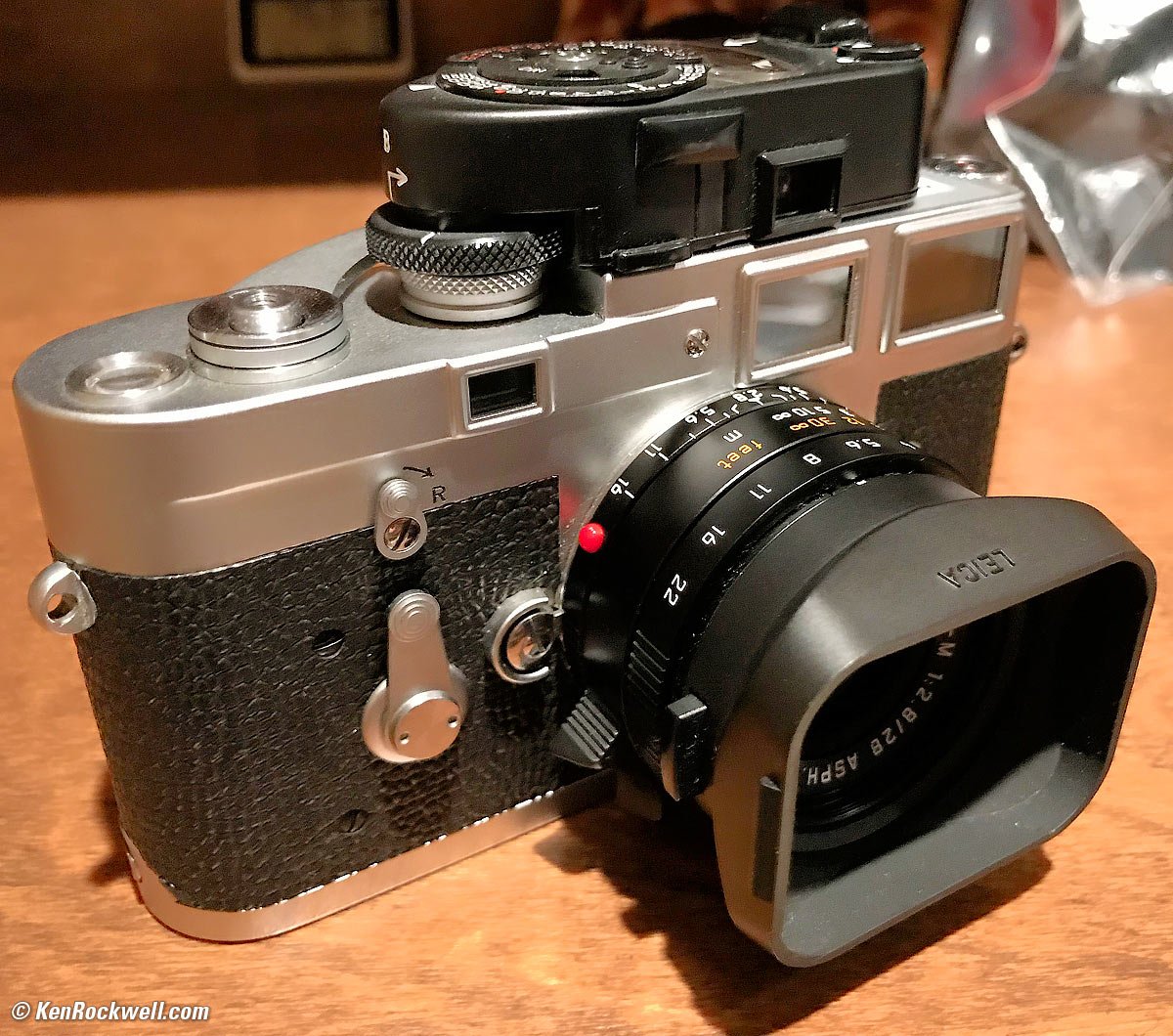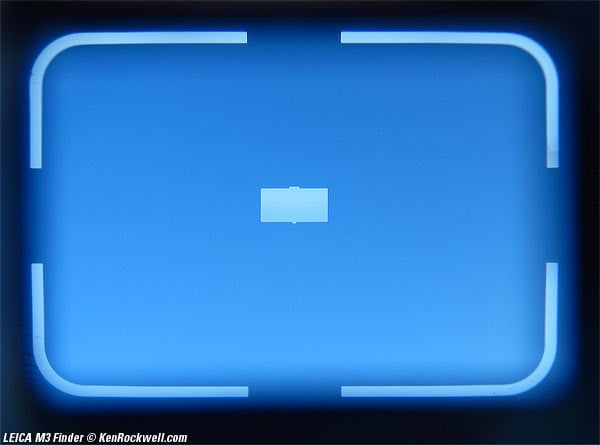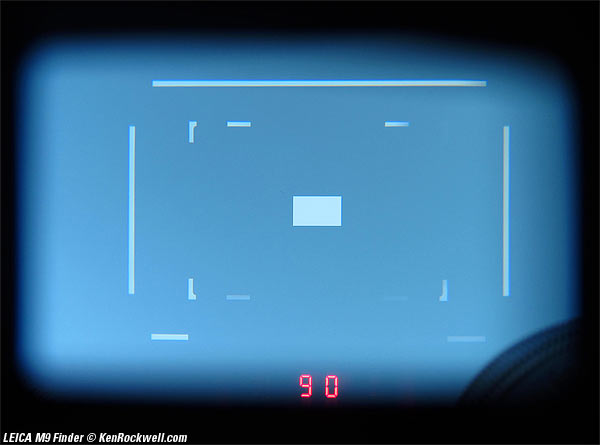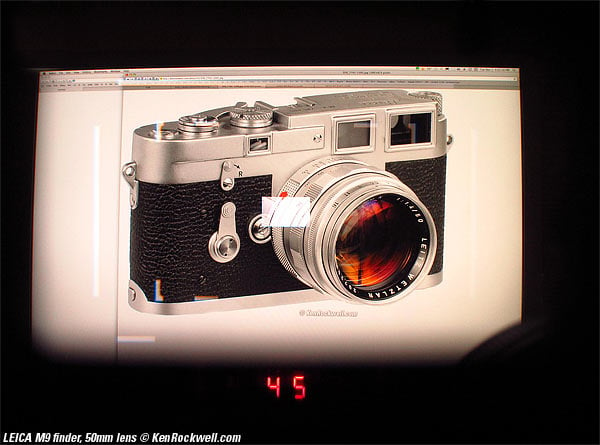LEICA M3
World's Greatest 35mm Camera (1954-1967)
Preface Intro Specs Performance Versions Compared Recommendations
auch in deutscher Sprache/also in German
1955 LEICA M3 (21.4oz./610g with film, about $1,400) shown with LEICA SUMMILUX 50mm f/1.4. enlarge. This free website's biggest source of support is when you use any of these links, especially this direct link to the M3 at eBay (see How to Win at eBay), and you also can get them at Amazon. It helps me keep reviewing these oldies when you get yours through these links, thanks! Ken.
April 2020 LEICA Reviews LEICA Lenses All Reviews
LEICA M3 Buyer's Guide, including the various versions.
The LEICA M3 compared to the LEICA M9.
Why Fixed Lenses Take Better Pictures.
LEICA M3 Sample Image Galleries:
Bridal Veil Falls, Yosemite Valley, 5:04 PM, 16 May 2014. 1955 LEICA M3, 1957 LEICA SUMMICRON 50mm f/2 with near-focussing range, LEICA Orange filter, f/5.6 at 1/50 as read by LEICAMETER MR-4, expired Ilford Pan-F Plus 50, North Coast Photo Services process and scan, Athentech Perfectly Clear, split-toned print. bigger.
NEW: Sample Images from Yosemite 16-18 May 2014
Yosemite in Winter February 2011
Route 66 February 2011
Yosemite and the Eastern Sierra October 2009
Route 66 February 2010
Death Valley February 2013
Good
 The LEICA M3 is the best camera that LEICA has ever made, and by many accounts, the best camera of all time. This is why it's also LEICA's best-selling camera of all time:
The LEICA M3 is the best camera that LEICA has ever made, and by many accounts, the best camera of all time. This is why it's also LEICA's best-selling camera of all time:
 The LEICA M3 has LEICA's biggest and best finder, and offers the most precise focus of any LEICA. The LEICA M3 offers more precise focus for use with lenses like the 50mm f/0.95 NOCTILUX-M than any other LEICA, especially better than today's LEICA M9.
The LEICA M3 has LEICA's biggest and best finder, and offers the most precise focus of any LEICA. The LEICA M3 offers more precise focus for use with lenses like the 50mm f/0.95 NOCTILUX-M than any other LEICA, especially better than today's LEICA M9.
 The LEICA M3 never puts another frameline inside the one you're using, unlike newer, lesser LEICAs.
The LEICA M3 never puts another frameline inside the one you're using, unlike newer, lesser LEICAs.
 The LEICA M3's ultrasmooth, quiet, solid and precise mechanics are much better than the LEICA M9. The M9 is noisy and clunky compared to the smooth-as-silk LEICA M3. With the LEICA M3, every time I hear the second curtain delicately slide home, I know I have just created another perfect photograph that will remain immortal for all time.
The LEICA M3's ultrasmooth, quiet, solid and precise mechanics are much better than the LEICA M9. The M9 is noisy and clunky compared to the smooth-as-silk LEICA M3. With the LEICA M3, every time I hear the second curtain delicately slide home, I know I have just created another perfect photograph that will remain immortal for all time.
 The LEICA M3 is perfectly compatible with every LEICA M lens (1954-today), and with a simple adapter, perfectly compatible with every screw-mount lens (1933-today). LEICA has made lenses from 16mm through 400mm for use with the M3. The longest lenses use a reflex housing.
The LEICA M3 is perfectly compatible with every LEICA M lens (1954-today), and with a simple adapter, perfectly compatible with every screw-mount lens (1933-today). LEICA has made lenses from 16mm through 400mm for use with the M3. The longest lenses use a reflex housing.
 When used properly with the coupled LEICAMETER MR or LEICAMETER MR-4, the LEICA M3 becomes an ergonomic joy, with foolproof semi-automatic exposure that just takes pictures.
When used properly with the coupled LEICAMETER MR or LEICAMETER MR-4, the LEICA M3 becomes an ergonomic joy, with foolproof semi-automatic exposure that just takes pictures.
Bad
 Most LEICA M3 that have sat unused since the 1970s will need an overhaul, after which, they will be as good as new.
Most LEICA M3 that have sat unused since the 1970s will need an overhaul, after which, they will be as good as new.
Preface top
Preface Intro Specs Performance Versions Compared Recommendations
It's taken me about two years get to reviewing the LEICA M3, because trying to review the LEICA M3 is about as meaningful as trying to review any other immortal masterwork, like Beethoven's 9th Symphony or the Mona Lisa. To those who already appreciate it, there is nothing more I could possibly add, and to those who don't, there is no way a review could possibly convey the brilliance and eternal genius these works contain.
If you're not a Beethoven fan, think of your favorite artist's most extraordinary work. It's incredible, yes? And how could you possibly convey its greatness to someone by simply writing about it? You can't; they have to experience and appreciate it for themselves.
Ratings of the features and specifications of any masterpiece never properly convey its brilliance. A masterpiece is far greater than the sum of its parts; it is a masterpiece precisely because its genius renders it greater than its parts alone.
Does anyone count how many notes Mozart used? Of course not; just like great photography, Mozart's brilliance often lies in how few notes he used to express his points more clearly than if he had used more. What makes a masterpiece a masterpiece is completely intangible and indescribable. It must be appreciated on its own. We can discuss the various things that comprise a masterpiece, yet the masterpiece goes beyond any of these descriptions.
When LEICA advertised LEICA M3 as a "lifetime investment in perfect photography," they had no idea how much of an understatement this would become. Most LEICA M3s sold today come from owners who have left this world; like any other masterpiece, the timeless LEICA M3 outlives its mortal owners. The M3 is good for more than a single lifetime of perfect photos; it's good for innumerable lifetimes. LEICA still services them, and plenty of other service facilities have no problem getting parts for it. Like other classics of incalculable value, parts are made new today for them.
This is why the LEICA M3, although scaldingly expensive in its day, still remains as LEICA's largest selling camera ever, with about a quarter-million copies sold. Every other LEICA since has been a step down, and the market has responded accordingly.
Cameras are simply light-tight boxes that hold a lens in front of film (the easy part), and some sort of viewfinder, exposure and focus system (the hard part). The LEICA M3 is superior to every other camera, and to every other LEICA, precisely because of the M3's superior finder system.
The LEICA M3 is the camera to which every other camera has attempted to compare itself for seven decades: the 1950s, the 1960s, the 1970s, the 1980s, the 1990s, the 2000s, and now in the 2010s.
In Steve Job's June 7th, 2010 introduction of the iPhone 4, Steve Jobs described his iPhone 4 as "This is one of the most beautiful designs you've ever seen. This is beyond a doubt one of the most precise and beautiful things we've ever made. Glass and steel, its closest kin is like an old LEICA camera." Note the reference to old LEICA camera; LEICA's offerings today don't measure up to the M3.
The LEICA M3 is Glory incarnate. The LEICA M3 is Perfection rendered immaculate.
To quote from the M3's instructions, "You are holding a LEICA in your hands — we hope you will derive as much pleasure from it as the multitudes of confirmed LEICA enthusiasts all over the world. In the LEICA M3 you have the utmost in photographic performance, speed, and convenience that we, as specialists in high-grade optical precision instruments, can provide. Such a camera does not come into being from one day to the next. It most favorably combines the experience of a long tradition in the design of scientific instruments with the latest advances of modern optics. It has matured through the many thousands of tests and trials at the hands of the elite of international photographers. You will see for yourself the scope and precision of the LEICA and how in many years' time it will still be as exact and reliable as it is now." This is what LEICA shares after you've bought the camera!
You won't see messages like this for the disposable cameras of today; the first thing you see after the table-of-contents in the LEICA M9's user's manual are instructions for its disposal as household waste!
Am I worthy to review the LEICA M3? Hardly; nor is any mortal. The LEICA M3 was the most advanced camera in the world when I was born, it is today the world's best 35mm camera, and most likely will be long after I pass from this Earth.
Front, 1955 LEICA M3 und LEICA SUMMILUX 50mm f/1.4. enlarge.
Introduction top
Preface Intro Specs Performance Versions Compared Recommendations
Nomenclature Prices and Part Numbers
Top, 1955 LEICA M3 und LEICA SUMMILUX 50mm f/1.4. enlarge.
The LEICA M3 is a brilliantly simple jewel of mechanical and optical perfection. The LEICA M3 is an entirely mechanical rangefinder camera which uses interchangeable lenses and whose viewfinder selects framelines automatically as any lens is attached. (Today's dirty little Voigtländer cameras or the Nikon SP still can't select the framelines automatically.) The thumb-wind lever advances film and cocks the shutter, any of several different models of LEICAMETER slips on top and couples to the shutter dial for instant semi-automatic exposure setting.
The LEICA M3 is today's best 35mm camera because it does what a 35mm camera needs to do better than any other 35mm camera.
Up through the 1990s, 35mm cameras were used professionally to cover news, sports and action, so SLRs, like the Nikon F5, ruled.
Today, digital has replaced 35mm for action, leaving 35mm as a medium for careful photography of nature, landscapes, and for creating timeless works art. Therefore image quality, ergonomics and portability are more important than frames-per-second, so the LEICA M3 reigns once again as the world's best 35mm camera.
The manual-focus LEICA M3 isn't the camera I'd use for fast action; it is the camera I prefer for careful photography of still subjects.
Among the many reasons the LEICA M3 is the world's best 35mm camera, especially today, is because it gets out of the way to let us make better pictures. The LEICA M3's simplicity and singularity of purpose lets us concentrate on our subjects and our pictures, instead of being side-tracked by having to think about a camera.
With the LEICA M3, we are free to pay attention to making a great image, and are never distracted by menus, settings, or pointless features added to lesser cameras as sales features, but which rarely help make better pictures.
Technically, the LEICA M3 is also the world's sharpest 35mm camera. Nikon and Canon SLR and rangefinder lenses don't measure up to LEICA lenses, and among LEICAs, the M3 offers the world's highest focusing precision — better than any other LEICA, ever.
Even if the LEICA M3 wasn't the world's best 35mm camera for actual shooting, it is also the world's best-made camera as an instrument unto itself. LEICA's understated advertising of 1954 properly described the LEICA M3 as "incomparable," like having an "848-jewel movement" and "astonishing." Camera makers don't use words like this today because no one, not even LEICA, makes cameras like this today.
The LEICA M3 has the world's biggest, brightest, sharpest, cleanest, clearest and most-accurate viewfinder and rangefinder system. (See also LEICA Finder Magnifications.) The Nikon SP's finder is nice, but colored, and its rangefinder spot is less brilliant, which was among the many reasons the Nikon SP flopped in the marketplace.
The LEICA M3 has a brilliant 0.91x viewfinder, and its flare-free rangefinder spot is the biggest, clearest and most accurate of any other camera. LEICA's newer cameras are all inferior.
The LEICA M3 is much smaller than you think. A Nikon D700 weighs twice as much.
In the 1959 novel Goldfinger, James Bond uses the LEICA M3 with LEICAMETER MC, deftly carried in his attaché, as yet one more impossibly expensive bauble of the ultra-rich.
While only those who also owned their own helicopters and platinum mines could afford a LEICA M3 in the 1950s, today, a LEICA M3 today sells for less than a Nikon D750. Forgive my gloating, but this classic LEICA equipment costs a lot less than today's made-in-who-knows-where plastic rabble from Nikon and Canon.
I enjoy using the LEICA M3 so much that I can't put it into words. There is no BS; just the settings you need and nothing else. The LEICA M3 is so well built that it's a treat just to touch it, much less adjust its delicious controls and to fire it. When I dream about which camera I want to take with me to go shooting, it's usually the LEICA M3.
Loading film into the brick-solid and Swiss-bank-vault-precise LEICA M3 completely overwhelms the dinky metal film canister and plastic-backed film; when you load an M3, you know the results will be extraordinary.
Setting exposure and focus with the semiautomatic systems of the M3 and LEICAMETER MR is trivially easy, much faster and easier than screwing with metering patterns, exposure compensations and stupefying autofocus-system tomfoolery of today's slowly blinking cameras.
The quiet, simple precision of shooting the LEICA is something I can't describe. If all I got was the same results as I get from digital cameras, this sublime pleasure of shooting would be worth it, but the results I get from film are superior to what I get with digital capture, both artistically and technically.
The mechanical M3 is silent as you wind and fire each shot. It takes just a second to set exposure, focus, aim, shoot, and wind for the next great shot. Unlike digital, all my shots come back perfectly exposed and in focus; I never have to make a second shot after seeing how bad one is on the LCD. That's why the M3 has no LCD: every shot is perfect, so why would you need an LCD?
No wonder LEICA advertised in 1957 that "99 out of 100 color photographs" seen in National Geographic were shot on LEICAs.
Shooting the LEICA M3 proves to me what I've been saying for decades: most of what we've been dealt in the past 60 years is just marketing BS. This older, higher-quality equipment takes better pictures, takes them more quickly and more easily, and costs less than the disposable plastic digital dross of today. These real cameras feel so much better than the digital plastic electronics that too many people confuse with cameras today.
Rear, 1963 LEICA M3. enlarge.
All previous (screw-mount) LEICAs used one eyepiece for focus, and a second peephole for framing.
The model previous to the LEICA M3 was the LEICA IIIf ("three-f," 1950-1957).
The LEICA M3 is called the "M" 3 because the rangefinder focusing spot is inside the viewfinder frame. "M" stands for "Messsucher," the German word for "measuring viewfinder," the key new feature of the M3.
While M stands for Messsucher, today we know that LEICA was too humble to use the word Meisterstück (Masterpiece), as we use to refer to the LEICA M3 today.
This is LEICA's first M camera. It's called the M3 because the viewfinder has three automatically selected framelines for three lenses: 50mm, 90mm and 135mm. 35mm lenses come with special reducing optics to change the 50mm finder into a 35mm finder, while one uses external finders with shorter lenses.
Prices and Part Numbers intro top
At introduction, the M3 cost about 50% more than the already very expensive and very popular screw-mount LEICA IIIf. LEICA spared absolutely no expense in making the M3!
Most cameras were sold with a 50mm lens at the same time; body-only sales were uncommon.
1954 Catalog Pricing
Code |
Catalog Price* |
Catalog Price** |
(in 1954 Dollars) |
|
| M3 and ELMAR 50/3.5 | IMARO |
$3,375 |
$2,825 |
$348 |
| M3 and SUMMICRON 50/2 | ISUMO |
$4,325 |
$3,630 |
$447 |
| M3 and SUMMARIT 50/1.5 | ISAIO |
$4,525 |
$3,800 |
$468 |
| Ever-ready camera case | IDCOO |
$150 |
$125 |
$15 |
| SUMMARON 35/3.5 | SOONC-M |
$950 |
$800 |
$99 |
| 35mm Finder | SBLOO |
$200 |
$170 |
$21 |
| SUMMARIT 50/1.5 | SOOIA-M |
$1,750 |
$1,460 |
$180 |
| ELMAR 90/4 | ELANG-M |
$900 |
$750 |
$93 |
| ELMAR 90/4 (collapsible) | ILNOO |
$1,450 |
$1,215 |
$150 |
| HEKTOR 135/4.5 | HEFAR-M |
$1,375 |
$1,150 |
$141 |
| VISOFLEX Focusing Housing with bayonet for LEICA M3 and screw thread to take long-focus lenses, inclusive of 5x focusing magnifier and double release | OZYXO-M |
$1,020 |
$850 |
$105 |
| HEKTOR 125/2.5 | HIKOO |
$1,425 |
$1,200 |
$147 |
| HEKTOR 135/4.5 short mount | OHEBO-M |
$1,365 |
$1,150 |
$141 |
| TELYT 200/4.5 | OTPLO |
$1,500 |
$1,270 |
$156 |
| TELYT 400/5 | TLCOO |
$4,360 |
$3,650 |
$450 |
* corrected for inflation in 2020.
** corrected for inflation in 2010.
2020 used pricing top
Expect to pay about $1,400 for an M3 body if you know How to Win at eBay.
Expect to pay a dealer about $2,000 for a nice, usable M3 body.
Collectors will pay three or four thousand dollars for a really nice, unused M3 body in its box with papers.
2010 used pricing top
M3 bodies sold for about $1,000 each at eBay, where I got my two.
Collectors will pay two or three thousand dollars for a really nice, unused M3 body in its box with papers.
Expect to pay a dealer about $1,500 for a nice, usable M3 body.
If you use this direct link to the M3 at eBay, which is where I got my two M3s, you can pay about $1,100 for an M3 complete with a 50mm lens, if you know How to Win at eBay. Heck, if you are shrewd, I got my near-mint, L-sealed 1963 M3 with LEICAMETER MR and 50mm f/2 SUMMICRON (rigid), in its case, for about $900, delivered. All it takes is patience to get a deal. Budget a couple of hundred dollars for a complete overhaul, and it will be as good as new.
Body Caps top
Every LEICA M body cap works fine.
The best cap is the 14 056 metal-insert body cap, which shipped in red and white boxes in its day.
Specifications top
Preface Intro Specs Performance Compared Recommendations
See my LEICA M3 Buyer's Guide for a guide to the various versions of the LEICA M3.
Lens Compatibility
1960 Lens Line for the LEICA M3. enlarge.
1965 Lens Line for the LEICA M3. enlarge.
The LEICA M3 works great with all LEICA-M lenses, 1954-present. This most emphatically means that modern wonders, like the 50mm f/0.95 NOCTILUX-M, all 135mm lenses at full aperture, and the LEICA SUMMILUX-M 21mm f/1.4 ASPH all work great, as well as does every classic LEICA lens.
All LEICA screw-mount (M39) lenses, 1933-present, also work flawlessly, with an adapter. With these adapters, the framelines automatically set themselves, and focus works perfectly, too.
Every LEICA lens works flawlessly on the LEICA M3, unlike LEICA's lesser, newer cameras like the M typ 240, whose design flaws prevent proper operation with some of LEICA's greatest lenses like the 50mm SUMMICRON with near-focusing range.
Of course you'll need to use a separate viewfinder with lenses wider than 35mm.
This looks cute below, but you can't use the LEICAMETER MR-4 in the same shoe at the same time as the 28mm finder you'd need:
LEICA 28mm f/2.8 ASPH on LEICA M3 mit LEICAMETER MR-4. bigger.
Finder top
See also LEICA Finder Magnifications.
Magnification
0.91x. The Nikon D3X has only an 0.7 x finder!
0.64x with 35mm lenses.
1.36x with 135mm f/2.8 lens.
Lenses covered
35mm, 50mm, 90mm and 135mm.
35mm lenses designed for the M3 optimize the finder's magnification.
For shorter lenses, or 35mm lenses not intended for the LEICA M3, use an external finder, as one does with every other LEICA.
Parallax Correction
Automatic.
Rangefinder top
Base Length
69.25mm
Effective base length
63mm. (69.25mm x 0.91 finder magnification).
Focus Measurement Range
Rated 1 meter to infinity.
Works to somewhat closer distances in practice.
Couples as close as 478 millimeters with the 50mm SUMMICRON in its close-focus range.
Film Loading, Advance and Rewind top
Loading
Hinged back and removable, dedicated take-up spool.
Film-type reminder
On back of camera.
Advance
Double-stroke or single-stroke thumb lever.
Finely ratcheted so it can be advanced in many smaller strokes.
Advance Confirmation
Revolving line, dot or dots inside rewind knob.
Frame Counter
Automatic reset as take-up spool is removed.
Stops at 40 exposures, but hash marks go to frame 44.
Rewind
Move lever to "R," lift knob, and twist.
Rewind knob does not rotate as film advances; only the center does to confirm advance.
Exposure and Metering top
Works with any of the coupled LEICAMETER M, LEICAMETER MC, LEICAMETER MR or LEICAMETER MR-4 for foolproof semiautomatic exposure setting.
The LEICAMETER automatically calculates exposures to as long as two minutes. Can your digital camera do this?
See also The LEICAMETER.
Shutter top
Horizontal cloth focal-plane.
1-1/1,000 and Bulb.
Infinitely variable shutter speeds, see Usage for details.
Flash Sync top
Gold internal sync contacts.
Unique rear sync terminals, need adapters to use with common PC cords.
Flashbulbs: Fully automatic synchronization to 1/1,000.
Electronic flash: Only to 1/50.
Self Timer top
Yes, settable anywhere from 5 to 10 seconds.
Remote Release top
Yes; shutter button threaded for standard cable release.
Weight top
1955 sample
21.565 oz. (611.3g), with 36-exposure film.
24.250 oz. (687.5g), with film, LEICAMETER MR-4 and Wein EPX-625 cell.
20.865 oz. (591.5g), without film, but with one sync adapter.
23.630 oz. (669.8g) without film, but with LEICAMETER MR-4 and one sync adapter.
32.305 oz. (915.9g) without film, but with 50/2 collapsible, metal lens cap, LEICAMETER MR-4 and sync adapter.
1963 sample (including two plastic sync caps)
21.310 oz (604.2g) with 36-exposure film.
24.000 oz (680.4g) with film, LEICAMETER MR-4 and Wein EPX-625 cell.
23.220 oz. (658.3g) without film, but with LEICAMETER MR-4 and Wein EPX-625 cell.
20.530 oz. (582.1g) mit out film.
(LEICAMETER MR-4 alone: 2.690 oz. (76.3g).)
Introduced top
April, 1954.
Quality top
Hand-made in the Holy City of Wetzlar, Germany.
Some few samples (about 7,000 or 3%) were given the dishonor of being off-shored to Canada. We'll ignore these, eh.
Performance top
Preface Intro Specs Performance Compared Recommendations
Finder
The M3's finder is superior to everything; I've already written that, now let's show it.
Here are two otherwise identical snaps of the LEICA M3's finder and the LEICA M9's finder, each looking at the sky with the same 50mm lens. We're not looking through the lens, but it does key-in the 50mm frame:
The M9's finder frames are thinner, weaker and less distinct. Worse, there is a 75mm frame inside the 50mm frame we want! There really isn't any bottom to the M9's 50mm frame, and it doesn't look any better during actual use.
With a blank sky, the M9's frame lines are visible. They are more difficult to see with actual subjects. Here's two more snaps, this time looking at my computer monitor with the same 50mm lens:
The M3's finder is to-the-point, while it's difficult to see the M9's frame lines lost inside a jumble of mush. With an actual subject, it's also obvious how much smaller is the M9's puny low-magnification finder.
Looking through the M3's finder is like sitting down in a real sports car or spacecraft: direct and to the point: you're in control and you're going to go!, while the M9's finder is more like sitting at the back of a bus: you're input isn't particularly relevant to whatever's going to happen. The M3's finder is all about control and your subject, not confusion.
Every other LEICA finder is smaller than the M3. After using the M3, every other LEICA finder seems broken by comparison.
LEICA got cheap after the M3, and has been making their finders much less complex to save money, but incapable of the high magnification of the M3. This reduces focus accuracy, so much that the puny 0.68x finder of the LEICA M9 comes with a warning in the instructions not to use 135mm lenses at their widest apertures because the M9's finder lacks sufficient accuracy!
The M3 has real, complete rectangular frames; even more than the 35mm and 50mm frame, the 90mm and 135mm frames are real, square-sided rectangles. Other LEICAs make do with mere line segments, or just corners, while the M3 projects big, bright and complete rectangles.
The M3 never pollutes your view with irrelevant frames inside the one you are using. By comparison, it's hard to find a lens with newer LEICAs whose finder frame isn't polluted with other irrelevant frame lines.
The M3's viewfinder is far more accurate than the newer, cheaper finders. My M3 shows me what I get on my slide mount, while LEICA M9 images include much, much more than shown in its finder.
With the M3, what I see is what I get. With an M9, I get weaker, looser compositions than I intended. This isn't about close-focus design differences, it's about what I get on my film in real shooting. Try it for yourself.
The M3's finder has the snappiest, contrastiest rangefinder I've ever used. Focus pops in so clearly and immediately that its almost startling!
The M3's finder is a little cool on the color balance side, nothing I've noticed before I ran these comparisons above and printed the results.
Yes, newer finders are antireflection coated as a marketing exercise to attempt to imply that they might offer more contrast or transmission than an M3, but look through a clean M3's finder, and you'll see that there is no comparison. There is no substitute for the LEICA M3's superior magnification. The LEICA M3 also uses real ground-glass for its frameline-illuminating window, while LEICA's newer cameras make do with molded plastic.
Because it's plain glass, the LEICA M3's finder stays cleaner and clearer with use and fingerprints, compared to the easily soiled finders of LEICA's newest cameras. The difference is that fingerprints are obvious and distracting on the coated front windows of newer cameras, but not distracting on the uncoated windows of the LEICA M3.
No matter how difficult the subject or your lighting, the M3's rangefinder spot never flares. It's always contrasty and easy to focus. All newer finders are inferior, and can flare when pointed towards light sources, making it nearly impossible to focus.
To compare this yourself, look through a finder and cover both the viewfinder (main) and rangefinder (smaller) windows, leaving only the center frameline illuminating window uncovered.
Now point the camera into the light and move around your eye. You should see nothing but bright frame lines and blackness.
In the M3, this is what you'll see.
In every other camera, you'll see the rangefinder spot light up with varying amounts of flare as you move your eye.
The early LEICA M7s are horrible at this, while today's M7, MP and M9 are much better, but nowhere near as good in difficult conditions as the LEICA M3.
Ergonomics performance top
There is nothing like the LEICA M3. Its finder is always big, bright, uncluttered and clear. No other camera looks or feels so good!
Everything is so smooth and precise — far better than today's LEICAs — that the LEICA M3 is a joy to hold and operate, even without film. Its solid-brass wind lever works great; more solid and faster than the plastic thingys on lesser LEICAs.
The M3's shutter release is more than just one gloriously smooth push to save an instant for an eternity: there is no lateral play in the shutter release button! That's right: while mortal cameras like the LEICA M typ 240 have shutter buttons that wobble from left to right as they press-in, the shutter button of the LEICA M3 only goes straight in towards its mark, unwavering and without lateral play, exactly like the vision and determination of the LEICAMAN. The shutter buttons of newer cameras, like the LEICA M7, M8 and M9, have additional nasty, distracting kinks in their travel, while the M3 (as well as LEICAs through the M6 TTL) enjoy only one smooth push.
The lack of kinks in the shutter release lead to less camera shake, and therefore sharper pictures.
90% of a camera is its finder, and the LEICA M3 has the best rangefinder finder ever created.
The LEICA M3's frame lines are never cluttered, meaning that one never has a frame for another lens appearing inside the frame with which one is trying to compose. Newer LEICAs can't do this.
It is astonishing how quickly and clearly perfect focus snaps-in, and how brilliant and clear is the frame in which one composes. There are no distractions; your attention in on nothing except one's subject and composition.
Because of the large magnification, focus is more precise than with other LEICAs, again leading to sharper images.
The M3 and its LEICAMETER requires just the right amount of reflection for each photo. The M3, exposure and focus never delay anything, and the simple finder allows one to concentrate on creating the strongest picture. As I was shooting in Bodie in October 2010, for every snap I made carefully, at least ten other people buzzed by like flies as they snapped away on their plastic digitals without FARTing, making scores of forgettable snapshots to be deleted an hour later.
The M3 shoots best when used with a genuine LEICAMETER, especially the LEICAMETER MR or LEICAMETER MR-4.
With the coupled LEICAMETER MR or LEICAMETER MR-4, press a button, set the indicated aperture, and shoot.
The shutter speed dial of the M3 is not intended to be turned directly; it is too small. The LEICAMETER has a much larger knob which couples directly to the camera's speed dial. The LEICAMETER's dial is big and well knurled, so speeds are easily set with one's shutter finger from the front of the camera.
Unlike cameras that use rotating cranks for rewind, the M3's rewind knob never gets caught in your hand when shooting vertically. The LEICA M3's rewind knob does not rotate as the film advances because it is declutched from the film's spool until the knob is lifted for rewind. A small central section does rotate to confirm film advance visually. This little knob may take longer to rewind, but LEICA shooters are in no hurry. If you are, LEICA sells an optional LEICA Rewind Crank.
The shutter speed dials of the earliest M3s are shiny chrome-plated turned brass, which are much harder to read in direct sunlight than the matte-finish knobs of later M3s. This isn't important, as one should be using the LEICAMETER to move the shutter speed dial, in which case the camera's dial is covered.
Shutter performance top
The LEICA M3 is so smooth when it fires, compared to the flipping mirrors of SLRs, that 1/2 second exposures are easy. Screw VR, IS and tripods.
The LEICA M3 shutter is pretty much the same as every other LEICA shutter since the 1920s: slow, quiet cloth.
Slower speeds (like 1 second) will have some afterbuzz, meaning that they are supposed to buzz a little bit after the exposure completes. Feel free to advance the film without waiting for the buzz to stop.
1/50 sounds slightly more metallic than the faster speeds.
The faster speeds are but an almost silent, soft click, while slower speeds add a slight interval between two even softer clicks.
Unlike SLRs, the only thing going on when you take a picture is two pieces of soft cloth moving about two inches to the left.
Focus Accuracy performance top
While focus precision is a factor of camera design, and the LEICA M3 has more focus precision than any other LEICA, focus accuracy depends on the calibration of your particular sample of camera body, the calibration of every sample of lens, and how well the two samples work together.
While largely invisible in its day, with high-resolution film scanning so popular today, it is much easier to see even the slightest errors in focus. This is because looking at a 3,600 DPI scan at 100% on a computer is a 36x magnification of the film, the same as looking at a 33 x 50" (85 x 130 cm) print, just inches from your face. Back even as recently as the 1980s, no one regularly looked at all their photos this closely, but today, even the very slightest focus inaccuracy is obvious at this magnification.
Therefore, your results will depend on sample variation. Yes, LEICA lenses and camera bodies vary from sample-to-sample, and you will have to hand-pick which lenses work best on your M3. Lenses up to 50mm should all be perfect, while probably only half of the 90mm and longer lenses you try will be right-on.
This is normal for all rangefinder cameras.
Frame Counter performance top
Automatically resets as you remove the take-up spool.
Stops counting at 40 exposures, but hashed to frame 44.
Film Economy performance top
I get 39 perfect frames on a roll of Fuji 36.
Kodak isn't as generous; I get only 38 frames per roll of Kodak 36.
Film Flatness performance top
The film stays flat in the LEICA M3; much better than in the Nikon F6 or LEICA M7. I have no idea how or why the M3 is better than the M7, but the few times I've tried this, it is.
Often the second shot of the day in an F6 is blurred because the kink in the film where the film first starts wrapping around the spool in the film can is drawn to the film gate, and it isn't held flat enough to keep everything in focus at large apertures.
I've done this same thing with a LEICA M3, and even shot wide-open, the film is held so flat that everything remains perfectly sharp at f/2.
Rewind Speed performance top
About 25 to 30 seconds, using the little knob.
Real LEICA photographers grab only the rewind knob and use it as a pivot with which to spin the entire camera around while holding it over their heads; I don't do that.
Serviceability performance top
Parts are readily available.
Excepting deliberate destruction or inept repair attempts, an M3 can be rebuilt for an unlimited number of lives.
Compared top
Preface Intro Specs Performance Compared Recommendations
In the 1950s, Oriental makers did as we expect, and Nikon made a camera, the Nikon SP, with superior specifications and features on paper, and it sold for only about 2/3 the cost of the LEICA M3. Nikon still hasn't figured out why the Nikon SP only sold one-tenth as many cameras as the LEICA M3: the SP lacked genius, more specifically, the Nikon SP had more finders and frame lines, but asked that you used two different finders to do what the LEICA M3 does better with just one! The Nikon SP also came from the stone age, demanding that you stop and change finder frames manually.
There is no comparison to the LEICA M3; everything else is inferior. LEICA has never outdone itself, and no one has outdone LEICA.
Every other LEICA since the M3 has been an inferior cost-reduction that merely plays on the M3's genius in an attempt to keep selling cameras.
If I dare compare the LEICA M3, the LEICA M2 (1957-1967), the "poor mans's LEICA," used a lower-magnification finder with a simpler, cheaper and inferior rangefinder system. It also lacked the automatically-resetting internal frame counter of the M3, and uses a primitive external wheel as a film counter, requiring manual resetting for every roll!
The LEICA M1 (1959-1964) removed the rangefinder entirely for microscope and reflex (VISOFLEX) use.
The LEICA M4 (1967-1975) was an M3 with a canted rewind crank, and used an inferior, lower-magnification finder with a simpler, cheaper and inferior rangefinder system.
The LEICA M5 (1971- 1975) was a big, ugly failure.
The LEICA M4-2 (1978-1980) and LEICA M4-P (1981-1987) were made even cheaper again, with low-magnification finders and flare-prone rangefinders. Production was moved offshore to save even more money.
The LEICA M6 (1984-1998) and LEICA M6 TTL (1998-2002) were cheaper cameras, with zinc, not brass outer plates, and made not in the Holy City of Wetzlar, but elsewhere in Germany. They also use low-magnification (0.72x) finders, but at least some versions offered a less-low magnification (0.85x) finder that is the next best thing to the superior M3 finder. Worse, the LEICA M6 TTL has a design flaw (too-tall a top plate) that prevents it from working with LEICA's greatest lens, the LEICA 50mm SUMMICRON with near-focusing range, in its close-range.
The LEICA M7 (2002-) uses an inferior low-magnification finder, and also has a design flaw preventing its use with the near-range of the LEICA 50mm SUMMICRON with near-focusing range. The M7 also offers an optional 0.85x finder, the best available today, but still inferior to any old M3.
The LEICA MP is but another attempt to simulate the M3, so again, why settle for a mediocre finder when you can enjoy a real M3, with a far better finder, instead? The MP offers an optional 0.85x finder, inferior to any M3.
The LEICA M9 has almost nothing in common with the LEICA M3, except sharing the mount, the basic rangefinder layout and some outward similarity in appearance. The M9 is sort of like the crudeness of a Polaroid SX-70 crossed with an M3 with a broken viewfinder. See also The LEICA M3 compared to the LEICA M9.
The M typ 240 shares the mount. It's much bigger and heavier.
The LEICA M3 has an 0.91x finder, while the Nikon D3X has only an 0.7x finder, and lesser Nikon DSLRs have even smaller finders.
Recommendations top
Preface Intro Specs Performance Versions Compared Recommendations
Queen Elizabeth of England's 60th birthday commemorative postage stamp (17p and 34p, issued in 1986 in the UK) shows her with her own LEICA M3, which she's been using since 1958. She's shown in the image of her her 50th birthday, or in 1976, enjoying her nearly 20-year old (at the time) LEICA M3.
The only fluff features added to newer LEICAs these past 50 years has been a faster-loading take-up spool (retrofittable to the M3 with a conversion kit part nr. 14 260), TTL metering (which lacks the simplicity and hold function of the LEICAMETER MR and LEICAMETER MR-4), and the ability to show a 35mm finder frame with less-expensive lenses that lack the auxiliary finder optics of 35mm lenses designed for the M3. The problem with the extra 35mm frame in newer LEICAs is that this 35mm frame is too big to see it all at once, and in exchange for this questionably useful 35mm frame, the entire finder has been dumbed-down to a puny 0.72x for all lenses, making 50mm, 90mm and 135mm lenses far less useful.
Want to know a secret? 35mm lenses with the finder optics for the M3 work great on all newer LEICAs, and I prefer the smaller frame size called-up with these optics as an aid to composition!
Many newer LEICAs claim to have a 28mm frame, however it's so big that it's nearly impossible to see or use, and even if you can see it, you can't see all of it at the same time; you have to wiggle your eye around and look at it in sections, which is not the way to see a composition!
So why would anyone want any LEICA other than the M3? Beats me, and the market agrees: this is why LEICA has sold more M3s, even at platinum-mine prices, than any other camera.
Good enough for royalty, good enough for National Geographic and good enough for Miles Davis? Good enough for me, and an M3 still costs less than a Nikon D750!
See Also
LEICA M3 Buyer's Guide, including the various versions.
The LEICA M3 compared to the LEICA M9.
Help me help you top
I support my growing family through this website, as crazy as it might seem.
The biggest help is when you use any of these links when you get anything. It costs you nothing, and is this site's, and thus my family's, biggest source of support. eBay is always a gamble, but all the other places always have the best prices and service, which is why I've used them since before this website existed. I recommend them all personally.
If you find this page as helpful as a book you might have had to buy or a workshop you may have had to take, feel free to help me continue helping everyone.
If you've gotten your gear through one of my links or helped otherwise, you're family. It's great people like you who allow me to keep adding to this site full-time. Thanks!
If you haven't helped yet, please do, and consider helping me with a gift of $5.00.
As this page is copyrighted and formally registered, it is unlawful to make copies, especially in the form of printouts for personal use. If you wish to make a printout for personal use, you are granted one-time permission only if you PayPal me $5.00 per printout or part thereof. Thank you!
Thanks for reading!
Mr. & Mrs. Ken Rockwell, Ryan and Katie.
Home Donate New Search Gallery How-To Books Links Workshops About Contact
1955 tested 06 Feb 2013-Death Valley:
OK mit:
50 DR (1957)
90/2 (1960) silver
90/2.8 silver (1960)
90/2 silver (1994)
135/4 silver (1965)
